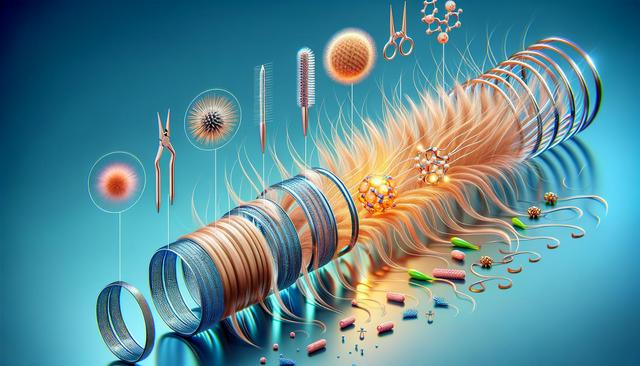Effective Steps to Manage Thinning Hair
Thinning hair can be managed with gentle hair care routines, scalp massages, and nutrient-rich diets. Avoid harsh styling tools and consider treatments like minoxidil or biotin supplements to promote regrowth and strengthen hair follicles over time.

Understanding Why Hair Thins
Hair thinning can result from a range of factors, and understanding the root cause is the first step towards managing it effectively. While genetics play a major role, environmental stress, hormonal changes, poor diet, and certain medical conditions can all contribute. In many cases, people experience gradual thinning over time, which can be particularly noticeable along the crown or hairline. Identifying patterns, such as whether the thinning is diffuse or localized, can help determine the most suitable approach for treatment.
Common causes of hair thinning include:
- Hormonal imbalances, such as those caused by thyroid issues or menopause
- Nutrient deficiencies, especially of iron, zinc, and vitamin D
- Overuse of heat styling tools and chemical treatments
- Stress and lack of sleep
- Genetic predisposition to conditions like androgenetic alopecia
By recognizing these factors early, you can tailor your approach to address the specific reasons behind your hair thinning.
Building a Gentle Hair Care Routine
One of the most important steps for thinning hair is adopting a gentle hair care routine. Harsh products and aggressive styling can worsen the condition and lead to further breakage. Instead, opt for sulfate-free shampoos and conditioners that are formulated to strengthen hair and support scalp health. Avoid washing your hair too frequently, as this can strip it of natural oils that are essential for moisture and protection.
Additional tips for a gentle hair care routine include:
- Using a wide-tooth comb to detangle wet hair
- Letting hair air-dry as often as possible
- Minimizing the use of flat irons, curling wands, and blow dryers
- Applying heat protectant products if styling tools are necessary
Consistency is key. Over time, a gentler approach can help reduce breakage and give your hair a healthier appearance, even as you work to address the underlying causes of thinning.
Incorporating Nutrient-Rich Foods
Nutrition plays a significant role in the strength and thickness of your hair. A well-balanced diet supports the body’s natural hair growth cycle and ensures that hair follicles receive the nutrients they need. Proteins, healthy fats, and vitamins are particularly important for maintaining strong, resilient strands.
Consider including the following nutrient-rich foods in your diet:
- Leafy greens like spinach and kale, which provide iron and vitamin C
- Fatty fish such as salmon and mackerel, rich in omega-3 fatty acids
- Nuts and seeds for zinc, biotin, and healthy fats
- Eggs, which are a good source of protein and biotin
- Whole grains and legumes, offering B vitamins and fiber
Supplements can also support hair health, but it’s important to consult with a healthcare professional before starting any new regimen. Biotin and other hair-focused supplements are popular choices, but individual needs may vary based on dietary intake and health status.
Exploring Scalp Treatments and Massages
Maintaining a healthy scalp is essential for promoting hair growth and reducing shedding. Scalp massages stimulate blood flow to the hair follicles, which can encourage growth and improve the overall health of your hair. Using oils like rosemary, peppermint, or castor oil during massages may enhance the benefits further, as these oils have been linked to improved hair density in some studies.
In addition to massages, consider scalp treatments that target thinning:
- Topical treatments containing minoxidil, which may help stimulate regrowth
- Products with caffeine or niacinamide to increase circulation
- Clarifying treatments to remove buildup and improve follicle function
Regular exfoliation of the scalp can also help maintain a clean environment for hair growth. Gentle exfoliating shampoos or brushes can remove dead skin cells and improve the absorption of topical treatments.
Managing Stress and Lifestyle Factors
Chronic stress can disrupt the hair growth cycle and contribute to thinning. When the body is under prolonged stress, it may enter a state called telogen effluvium, where more hairs than usual shift into the resting phase and eventually fall out. Managing stress effectively is therefore a crucial part of any plan to address thinning hair.
Practical ways to manage stress and support hair health include:
- Practicing mindfulness techniques such as meditation or yoga
- Engaging in regular physical activity to boost circulation and mood
- Getting adequate sleep each night to allow the body to repair and regenerate
- Limiting exposure to unnecessary toxins and pollutants
Creating a balanced lifestyle not only improves your overall well-being but also supports the natural functions that contribute to healthy hair. Small daily habits can make a noticeable difference over time.
Conclusion
Thinning hair can be a challenging experience, but with a thoughtful approach, it’s possible to manage and even improve its condition. By understanding the causes, adopting gentle care practices, nourishing your body from within, exploring supportive treatments, and managing lifestyle factors, you can create a comprehensive plan that supports healthier, stronger hair. Each step you take contributes to long-term improvement, making it easier to regain confidence and maintain a positive outlook on your hair journey.